Rone: Races of a New Era Review
Rone 2nd edition: Races of a New Era
A Review by Bob Nolan
[Disclaimer: I am not affiliated with the publisher but I have received a promotional copy of the game for this review.]
Product Name: Rone: Races of a New Era
Publisher: GREIFERISTO Games
Mechanics: Versus, Competitive, Card
Cost: $??
Genre: Post-apocalyptic
# of Players: 2-4
Time: 30-45 minutes
Ages: 14+
Designer: Stepan Stefanik
Rone: Races of a New Era is a strategic card game set in a bleak and dark future world. Players recruit survivors, warmachines, hybrids and mutants into your army to gain control of the new world. Use technology to your benefit by upgrading your armies and machines to be the new leader of the new order.

Introduction
Rone was Kickstarted and funded at 120% with 324 total supporters after the pledge manager ended in 2018. You can find the campaign for the 2nd edition and expansions here: https://www.kickstarter.com/projects/bonjour/rone-2nd-edition-rone-new-forces-expansion-relaunc
Rone is a competitive player VS player card game (battle card game) where players build various combos from the different cards. There is a large variety of cards, and the enormity of the choices may be overwhelming at times. For some, this is a good thing but for others it can mean slow learning.

In Rone, players will build a deck, either randomly, or through other means, such as drafting, before the game starts. A deck is composed of no more than 24 cards, which also represents your chosen hero’s health in the game. Players then, over a series of rounds and phases, play cards to create various combos to reduce the opposing player’s health (cards) to zero.
Components and Artwork
The core game includes a rulebook, 4 water dials, 10 damage and health tokens, 6 melee attack tokens, 6 ranged attack tokens and 360 cards. With a post-apocalyptic setting, artwork is important to draw players in. There are a wide variety and sundry different pieces of art and it does well to immerse players. The artwork is not distracting and this allows the important information to stay front-and-center.
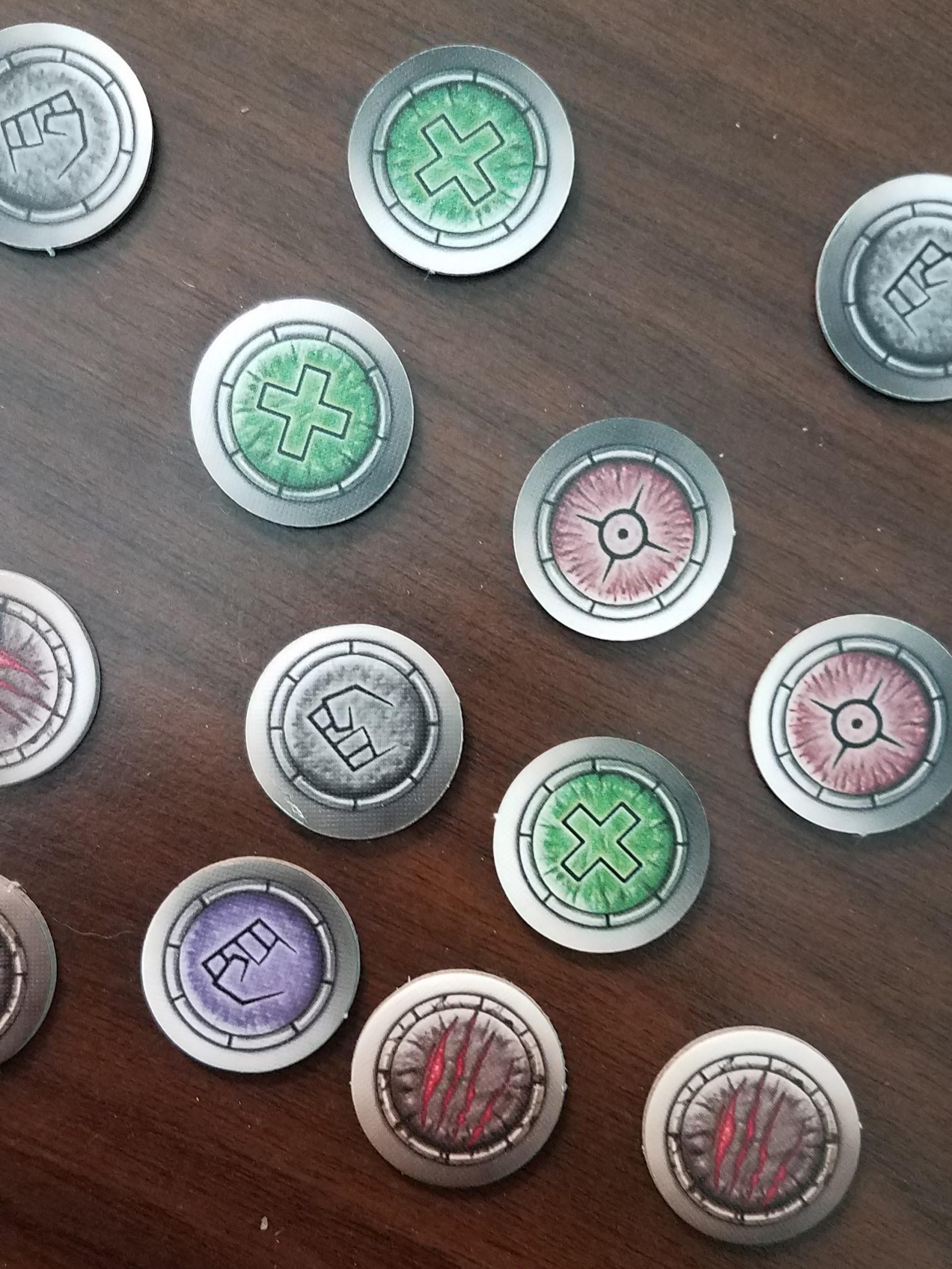
The components feel good and should stand up to many games. The dials that track resources work well and do a great job of keeping your water resource visible.
I would be a happy post-apocalyptic survivor to have this game in my possession based on component quality and artwork alone.
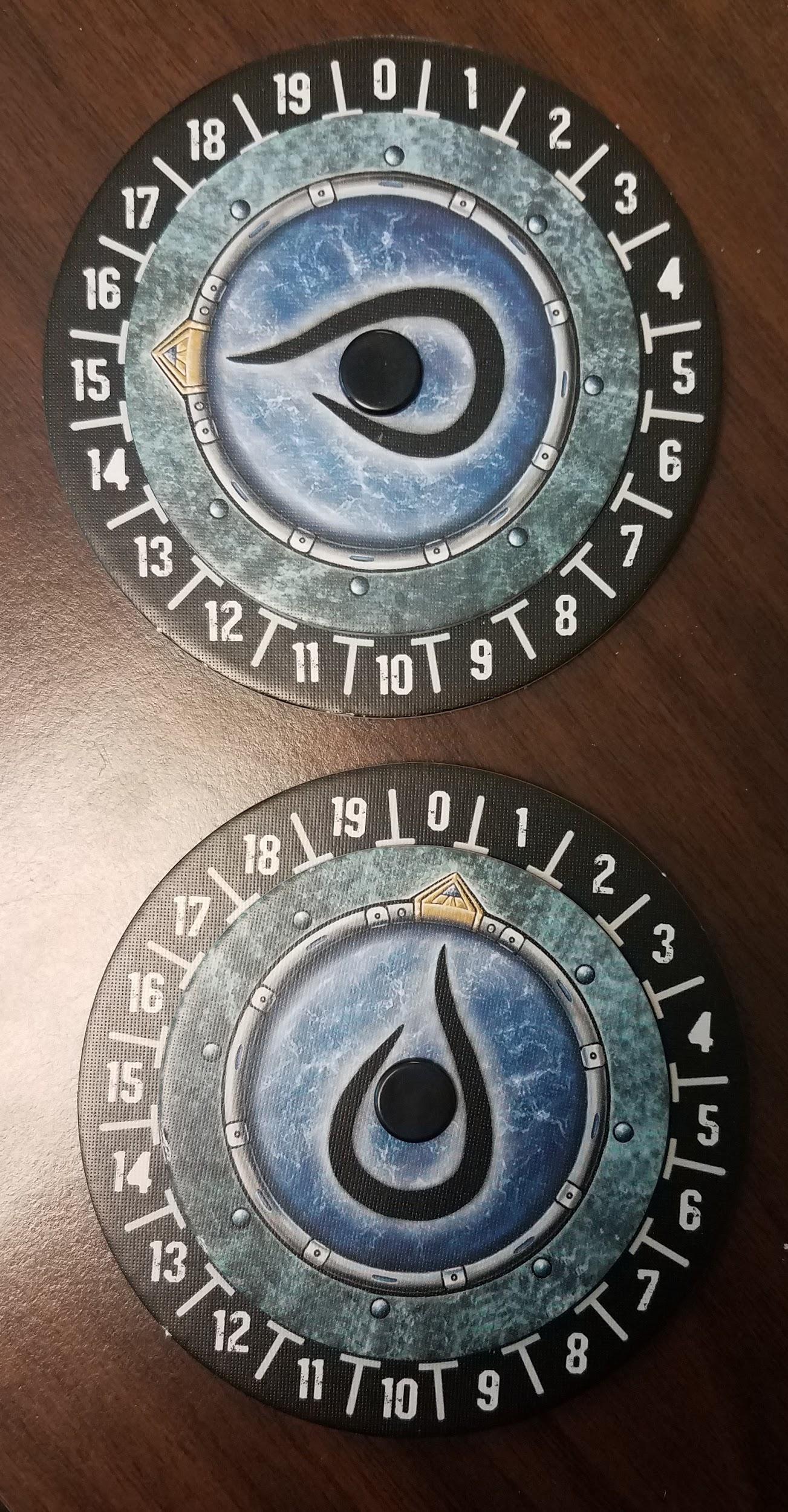
Game Play
As a new player to Rone, it took a few games before I started to become familiar with the cards and how they all interact. However, let’s look at set up and how the game is played.
Every player first chooses a hero from the many available choices. A hero has three levels and is placed in a stack. When levels change in the game, the appropriate card is used.
For your first game, you will prepare your player decks by randomly drawing 24 cards per player, plus the hero. The technology deck includes 5 random cards from the available technology cards. For your first game, this step is optional as it adds more complexity and interactions with the cards. The first player is chosen randomly. To offset the first player advantage, the second player begins with two water tokens while the first player begins with zero. Players draw a hand of six cards and may mulligan if they are not happy with this draw. The mulligan rule may be used once per game.
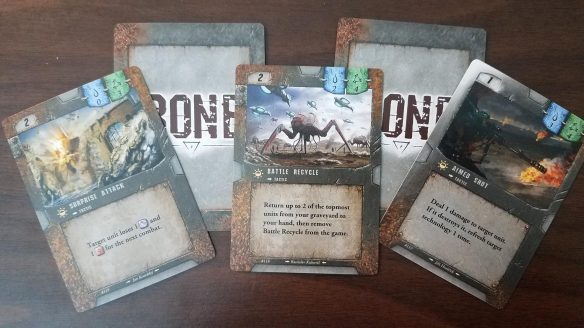
The main resource needed to activate various abilities and powers is water. As mentioned, the first player starts with zero water and the second player gets to start with two.
A game is played in rounds with five phases and players alternate turns following the phases. Those phases are, in order:
- Refresh phase
- Start of turn phase
- Income phase
- Main phase
- End of turn phase
Let’s look at a basic overview of each of the phases. The player following the steps of the phases is considered the active player.
First, the active player resets the cards that are in play- meaning they are rotated (when a card is used, it is rotated to track whether it is useable or not) and are then useable in the upcoming phases.
Next, some cards may activate at the “start of the turn,” and are triggered in phase 2. The active player makes sure to plan these triggered effects in any order they wish. When playing, be sure to trigger effects so that each works upon the effects created by the previous card. Finding potential combos here is fun and rewarding.
The third phase is income and this is where the active player gains more water resources as well as being able to draw more cards. Gain water tokens equal to the resource number on your hero card as well as cards as listed on the same hero card.
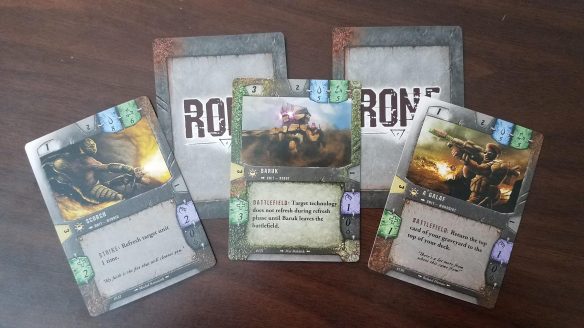
Unit Cards
The fourth stage is the main phase where card abilities take effect. There are two main categories of abilities, slow and fast. The main phase is where things start to get really exciting, and, depending on what cards you have in play, you can get several abilities working together. Slow effects can only be used during the active player’s main phase and can include things like playing unit or technology cards, declaring an attack, leveling up a hero, and more. Fast effects can be played as reactions to an opponent’s turn or during any other phase (except the Refresh phase). The fast effects come from reacting to a tactic card being played or an opponent executing an activated ability, and more.
Played cards in this phase are placed into a “stack” which can be reacted to. Once all cards are placed into this “stack,” they are activated in reverse order, from the top of the stack down. Since reactions are important and the actions from the “stack” can trigger reactions, it’s important to follow the rulebook and activate / trigger effects in the proper order. The idea from this wasn’t confusing, but, players have to be sure to follow the order of operations and make sure the triggers and reactions happen in the appropriate order.
In this phase, the orders players must follow are detailed as followed:
- Announce the action
- Attempt to cancel the action
- Activate the action
- Place the action onto the stack
- React
- Execute the action
The rulebook does a good job of making this part clear and concise and it’s handy to keep this section of the rulebook handy when learning the game.
As players play cards, they must pay for those cards by spending water, which is equal to the water cost as shown on the card. In addition, the hero chosen by the player has to be at the same level or higher than the card being played.
One thing to keep in mind is that a player can only ever have three technology cards on the table at any given time.
In addition to paying water to play cards, leveling up your hero requires water. When you level up, simply use the next appropriate card keeping the new card oriented the same way as the old card. If your hero was exhausted then the new card is exhausted.
In order to win a game of Rone, players need to attack the opponent’s forces and hero. Units are the only types of cards that can attack. Players can choose multiple units to attack, but order must be maintained.
First, a player announces the attack and from which unit the attack is coming from. The opponent may then react (by moving cards or preventing an attack). Next, the target of the attack is chosen. Combat then happens, but, that combat can be turned around so that the opponent now has the upper hand. Increasing or decreasing stats of various units is the usual way to do this and only fast effects can be played during this time. Next, damage is dealt starting with ranged attack damage and then melee attack damage. Next, the defender is exhausted if it survives the attack, then clean up is done.
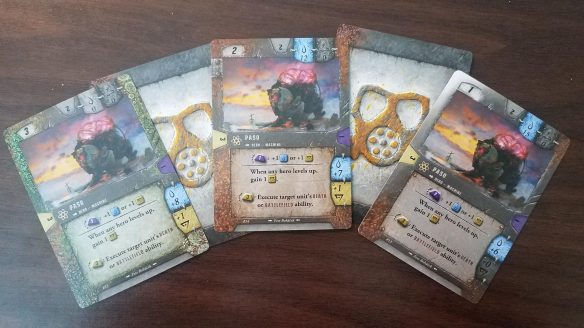
Unit Cards
At this point, the main phase is done and the end of turn is declared. The end of turn phase may activate more cards and the active player then follows all of those effects in any order chosen.
Although there are several phases and order is very important in Rone, the rulebook does spell out when and how to activate and use the different cards. The idea is simple, but, the concept provides some tactical depth and strategy is abundant based on cards in play and in your hand.
Game Design
The design is reminiscent of other strategy / tactical VS card games and turning the cards to exhaust them to use their abilities and spending resources to get cards into play is not a new concept. The process will be familiar to players who enjoy this type of game. Magic: the Gathering may come to mind when reading the rules and playing the game; however, this is a good thing because a lot of players understand how tapping and using requirements to play cards is used.
Even with the familiarity of the design, the types of cards and variety of units available in a deck keeps the game fresh. Replayability is good and additional card packs can be added to the game for even more choices throughout the game.
This type of game is not unique, but, the artwork, the various abilities and effects, are. Having reactions helps separate this game from other VS card games. In addition, the “stack” mentioned earlier also keeps this game fresh and exciting.
The current Kickstarter is looking to fund so they can create a delux or complete version of the game with updated rules and all previous expansions included. Backing the game would give players many, many games with a wide variety of experiences. Replayability, already great, increases.
Conclusion
RONE: Races of a New Era is not a new concept. However, the wide variety of cards and how you use them is. Having reactions and building the “stack” during the main phase with that stacks execution is.
The rulebook is done well and provides rules and alternative play styles to include multiple people into the game. The second edition game supports two, three, and four-player variants including a 2 v 2 mode.
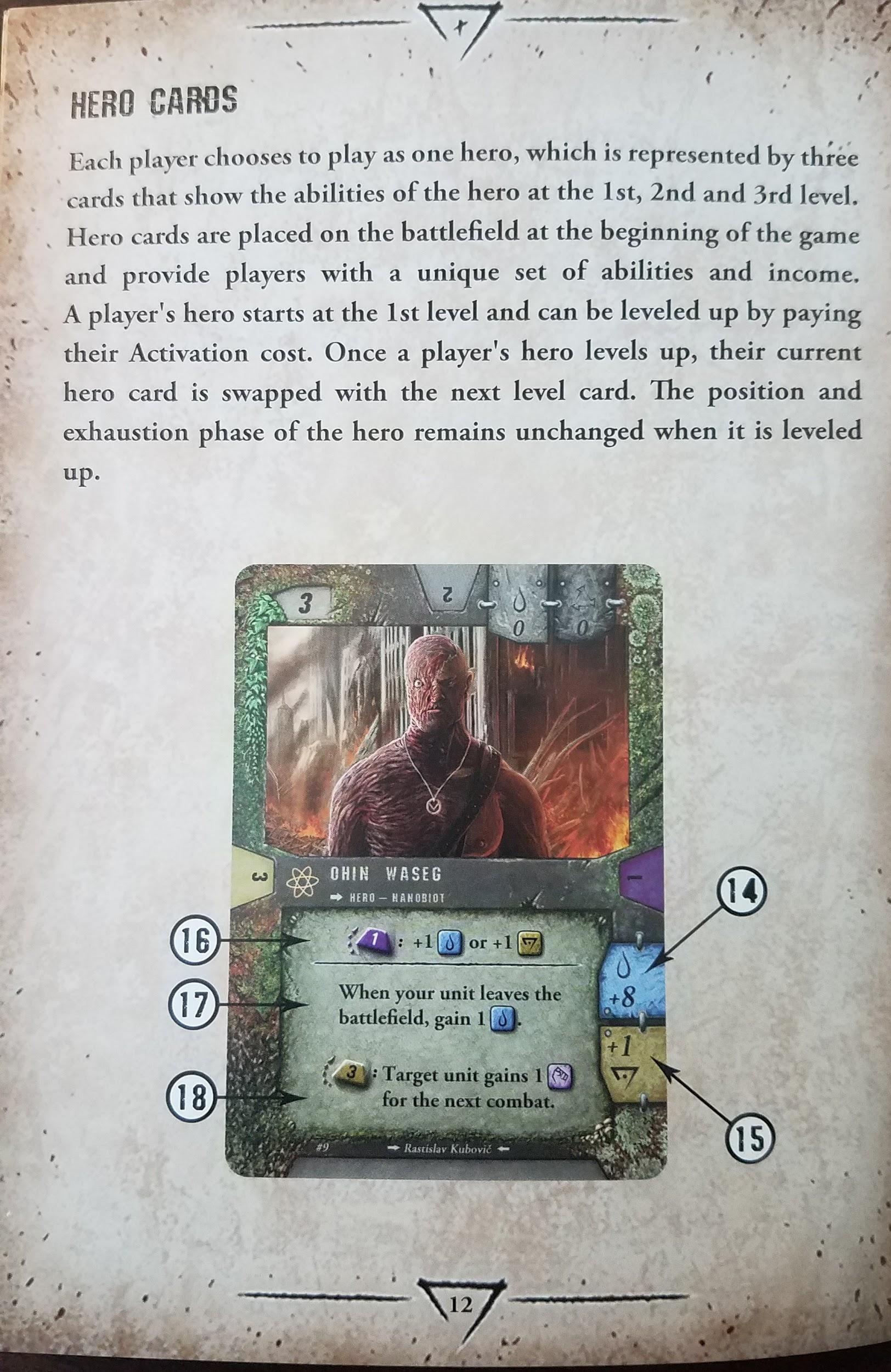
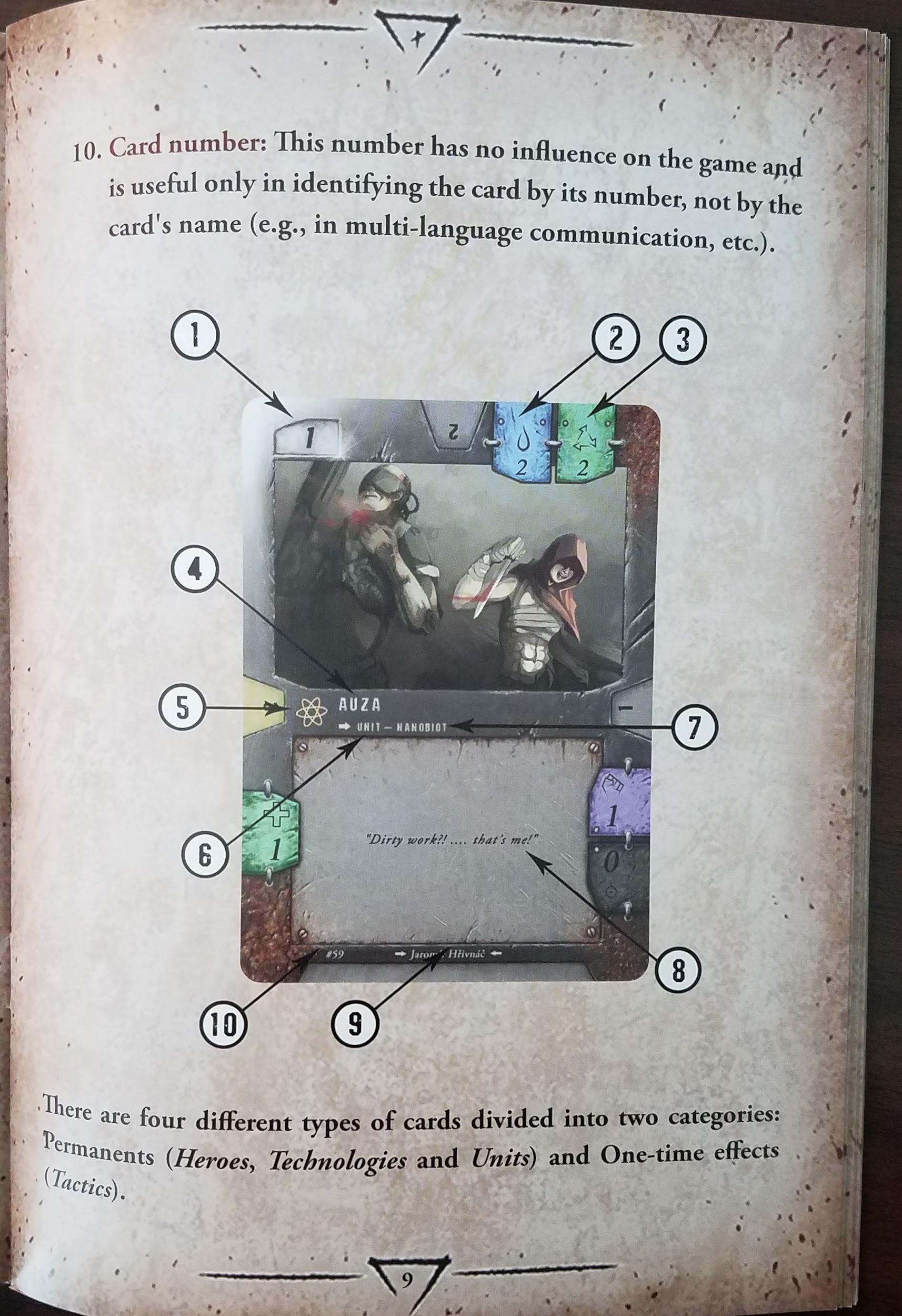
The artwork is gorgeous and builds the verisimilitude to immerse players into the post-apocalyptic world that the designer Stepan Stefanik has created. If you are a player who enjoys working card combos to devastating effect and playing games where you attack your opponent, then Rone is a great game to consider. Some players may not enjoy the targeting of the opponent to whittle their deck down. Whichever type of player you are, you will enjoy the artwork and some of the unique twists, reactions, and “stack” building that goes on in Rone. If you can support this indie publisher on Kickstarter, please do so.
To find this game on Kickstarter, visit: Kickstarter HERE
To find this game on Board Game Geek, click HERE.
https://boardgamegeek.com/boardgame/256122/rone-second-edition
To find Rone on Facebook, visit here:
https://www.facebook.com/RacesOfNewEra/

